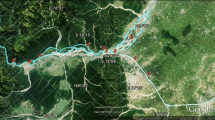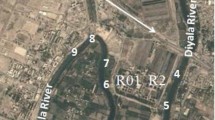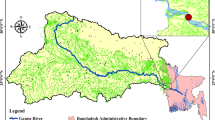Abstract
Ganga River system is a life support system to sustain the people of northeast region, India, by providing freshwater resource. In this study, the seasonal heavy metal concentrations of Ganga River system at Haridwar region (India) have been characterised for metal pollution. The collection of water samples was done from 10 different locations and analysed for various metal parameters (Zn, Pb, Mn, Fe, Cu, Si, Al, Ni, Cd, Mg and Co) using a standard laboratory procedures. The pollution level was assessed from the observed concentrations by using Heavy Metal Pollution Index (HPI) for nine heavy metals. The observed values of HPI were found lower than the Critical Pollution Index value of 100 (average value 78.62 and 81.18) during the study period. The concentration of Fe and Mg is exceeding the desirable limits of the World Health Organization, Bureau of Indian Standards and US Environmental Protection Agency in all water samples throughout the study period. The levels of all the metals were higher in the monsoon season and lower in the winter season. The Karl Pearson’s correlation matrix was developed by using the mean values of all parameters and showed the light intensity positively correlated with biochemical oxygen demand (BOD) and sulphate which indicate good microbial activity. Dissolved oxygen and BOD is found negatively correlated. From this study, it is easy to understand the various harmful effects of metal pollution to irrigation water and health of local people.

Similar content being viewed by others
References
APHA. (2012). Standard methods for the examination of water and wastewater (21st ed.). Washington, DC: American Public Health Association.
BIS (Bureau of Indian Standards). (2012). Specification for drinking water IS 10500: 2012, New Delhi, India.
Edet, A. E., & Offiong, O. E. (2002). Evaluation of water quality pollution indices for heavy metal contamination monitoring. A study case from Akpabuyo-Odukpani area, Lower Cross River Basin (southeastern Nigeria). GeoJournal,57, 295–304.
Environmental Protection Agency. (2012). A report on water: Monitoring and assessment. https://archive.epa.gov/water/archive/web/html/index-19.html.
Gupta, N., Yadav, K. K., Kumar, V., & Singh, D. (2013). Assessment of physico-chemical properties of Yamuna river in Agra city. International Journal of ChemTech Research,5, 528–531.
Joshi, D. M., Bhandari, N. S., Kumar, A., & Agarwal, N. (2009). Statistical analysis of physico-chemical parameters of water of River Ganga in Haridwar district. Rasayan Journal of Chemistry,2(3), 579–587.
Kashyap, R., Verma, K. S., Bhardwaj, S. K., Mahajan, P. K., Sharma, J. K., & Sharma, R. (2016). Water chemistry of Yamuna river along Ponta Sahib industrial hub of Himachal Pradesh, India. Research in Environment and Life Sciences,9, 277–281.
Khanna, D. R., Bhutiani, R., & Matta, G. (2011). Water analysis at a glance. Published by action for sustainable, efficacious development and awareness.
Mahato, M. K., Singh, P. K., & Tiwari, A. K. (2014). Evaluation of metals in mine water and assessment of heavy metal pollution index of East Bokaro Coalfield area, Jharkhand, India. International Journal of Earth Sciences and Engineering,7(04), 1611–1618.
Matta, G. (2010). Freshwater: Resources and pollution. Environment Conservation Journal,11(3), 161–169.
Matta, G., & Gjyli, L. (2016). Mercury, lead and arsenic: Impact on the environment and human health India. Journal of Chemical and Pharmaceutical Sciences,9(2), 718–725.
Matta, G., Gjyli, L., Kumar, A., & Machel, J. (2018a). Hydrochemical characteristics and planktonic composition assessment of River Henwal in Himalayan Region of Uttarakhand using CPI, Simpson’s and Shannon-Weaver Index. Journal of Chemical and Pharmaceutical Sciences,11(1), 122–130.
Matta, G., & Kumar, A. (2015). Monitoring and evaluation of River Ganga System in Himalayan Region with reference to limnological aspects. World Applied Sciences Journal,33(2), 203–212.
Matta, G., Kumar, A., Dhingra, G. K., Singh, P., Gjyli, L., & Kumar, A. (2018b). Limnological assessment of anthropogenic activities of River Henwal. Journal of Chemical and Pharmaceutical Sciences,11(1), 77–86.
Matta, G., Kumar, R., Kumar, A., & Gjyli, L. (2015a). Heavy metal analysis of industrial effluent allied with groundwater. ESSENCE—International Journal of Environmental Rehabilitation and Conservation,4(1), 33–40.
Matta, G., Kumar, R., Kumar, A., & Kumar, A. (2014). Effect of industrial effluent on groundwater quality with special reference to DO, BOD and COD. Journal of Sustainable Environmental Research,3(2), 183–186.
Matta, G., Kumar, A., Srivastava, S., Singh, V., & Dhingra, G. K. (2015b). Impact assessment of water quality of Ganga Canal System in Himalayan Region. International Journal of Scientific & Engineering Research,6(5), 1524–1531.
Matta, G., Pandey, R. R., & Saini, K. K. (2015c). Assessment of pollution on water quality and phytoplankton diversity in canal system of River Ganga. World Journal of Pharmaceutical Research,4(11), 889–908.
Matta, G., & Uniyal, D. P. (2017). Assessment of species diversity and impact of pollution on limnological conditions of River Ganga. International Journal of Water,11(2), 87–102.
Mohan, S. V., Nithila, P., & Reddy, S. J. (1996). Estimation of heavy metal in drinking water and development of heavy metal pollution index. Journal of Environmental Science and Health, Part A,31(2), 283–289.
Mudgal, K. D., Kumari, M., & Sharma, D. K. (2009). Hydrochemical analysis of drinking water quality of Alwar district, Rajasthan. Nature Science,7(2), 30–39.
Parsad, B., & Bose, J. M. (2001). Evaluation of heavy metal pollution index for surface and spring water near a limestone mining area of the lower Himalyas. Environmental Geology,41, 183–188.
Pulforda, D., & Riddell-Blackb, C. (2002). Stewarta. International Journal of Phytoremediation,4(1), 59–72.
Pushpa, R., Tiwari, A., Navin, R., & Sood, S. (2014). Studies in determination of some parameters of ‘Ganga river water, Kanwar Mela 2013, Haridwar. Journal of Innovative Biology,1(2), 122–125.
Ravindra, K., Ameena, M., Monika, R., & Kaushik, A. (2003). Seasonal variations in physicochemical characteristics of river Yamuna in Haryana and its ecological best designated use. Journal of Environmental Monitoring,5, 419–426.
Renberg, I., Persson, M. W., & Emteryd, O. (1994). Pre-industrial atmospheric lead contamination detected in Swedish lake sediments. Nature,368, 323–326.
Seth, R., Mohan, M., Singh, P., Rakesh, S., Dobhal, R., Singh, K. P., et al. (2016). Water quality evaluation of Himalayan Rivers of Kumaun region, Uttarakhand, India. Applied Water Science,6, 137–147. https://doi.org/10.1007/s13201-014-0213-7.
Sharma, R. K., Agrawal, M., & Marshall, F. (2007). Heavy metal contamination of soil and vegetables in suburban areas of Varanasi, India. Ecotoxicology and Environmental Safety,66(2), 258–266.
Sharma, R. C., Singh, N., & Chauhan, A. (2015). The influence of physico-chemical parameters on phytoplankton distribution in a head water stream of Garhwal Himalayas: A case study. Egyptian Journal of Aquatic Research,42, 11–21.
Sharma, M., Tobschall, H., & Singh, I. (2003). Environmental impact assessment in the Moradabad industrial area (rivers Ramganga-Ganga interfluve), Ganga Plain, India. Environmental Geology,43, 957–967.
Sheykhi, V., & Moore, F. (2016). Environmental risk assessment of heavy metals pollution in the aquatic ecosystem-a case study: Sediment of Kor river, Iran. Human and Ecological Risk Assessment,22, 899–910.
Singh, P. K., Tiwari, A. K., & Mahato, M. K. (2013). Qualitative assessment of surface water of West Bokaro Coalfield, Jharkhand by using water quality index method. International Journal of ChemTech Research,5(5), 2351–2356.
Sirajudeen, J., & Arul Manikandan, S. (2012). Seasonal variation of heavy metal contamination of ground water in and around Uyyakondan channel Tiruchirappalli district, Tamil Nadu. Pelagia Research Library,3(5), 1113–1119.
Tare, V., Yadav, A. V., Singh, A. V., & Bose, P. (2003). Analysis of photosynthetic activity in the most polluted stretch of river Ganga. Water Research,37(1), 67–77.
Tiwari, A. K., De Maio, M., Singh, P. K., & Mahato, M. K. (2015). Evaluation of surface water quality by using GIS and a Heavy Metal Pollution Index (HPI) model in a coal mining area, India. Bulletin of Environmental Contamination and Toxicology,95, 304–310.
Tiwari, A. K., & Singh, A. K. (2014). Hydrogeochemical investigation and groundwater quality assessment of Pratapgarh district, Uttar Pradesh. Journal of the Geological Society of India,83(3), 329–343.
Tiwari, A. K., Singh, P. K., Singh, A. K., & De Maio, M. (2016). Estimation of heavy metal contamination in groundwater and development of a Heavy Metal Pollution Index by using GIS technique. Bulletin of Environmental Contamination and Toxicology. https://doi.org/10.1007/s00128-016-1750-6.
Tyagi, S., Sharma, B., Singh, P., & Dobhal, R. (2013). Water quality assessment regarding water quality index. American Journal of Water Resources,1(3), 34–38. https://doi.org/10.12691/ajwr-1-3-3.
USEPA. (2009). National primary drinking water regulations. Federal register, EPA816-F-09-004. Environmental Protection Agency, Washington, DC.
Wang, G., & Fowler, B. A. (2008). Roles of biomarkers in evaluating interactions among mixtures of lead, cadmium and arsenic. Toxicology and Applied Pharmacology,233(1), 92–99. (PubMed: 18325558).
WHO. (2011). Guidelines for drinking-water quality (4th ed.). Geneva: World Health Organization.
Zhang, L. P., Ye, X., & Feng, H. (2007). Heavy metal contamination in western xiamen bay sediments and its vicinity, China. Marine Pollution Bulletin,54, 974–982.
Zhou, F., Liu, Y., & Guo, H. (2007). Application of multivariate statistical methods to water quality assessment of the watercourses in Northwestern New Territories, Hong Kong. Environmental Monitoring and Assessment,132(1–3), 1–13.
Author information
Authors and Affiliations
Corresponding author
Rights and permissions
About this article
Cite this article
Matta, G., Kumar, A., Tiwari, A.K. et al. HPI appraisal of concentrations of heavy metals in dynamic and static flow of Ganga River System. Environ Dev Sustain 22, 33–46 (2020). https://doi.org/10.1007/s10668-018-0182-3
Received:
Accepted:
Published:
Issue Date:
DOI: https://doi.org/10.1007/s10668-018-0182-3




